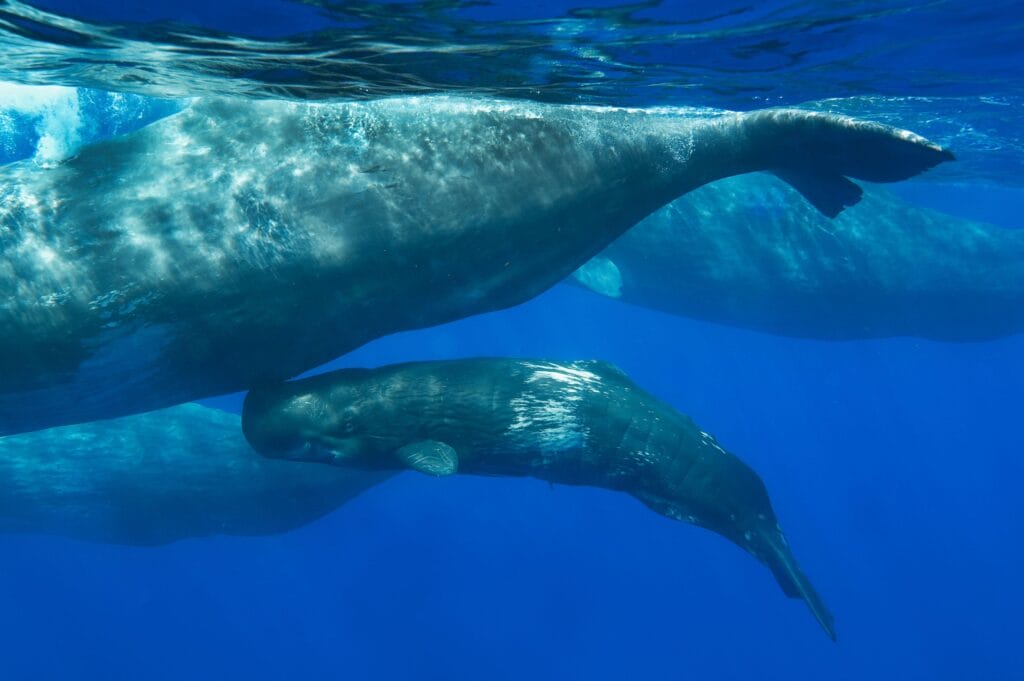
eNewsletter: July edition
Spotlight: Sperm whale
Each month we dive into fun facts, stories, and updates with our fin-tastic whale and dolphin loving community!
Did you know?
- Sperm whales can dive to depths of up to 3km (almost 2 miles) and hold their breath for an incredible 2 hours, although 45 minutes is the average dive time.
- Their other names are Cachalot and Pot whale.
- They each have an enormous square-shaped head which accounts for around a third of their body length.
- Their most recognizable trait is their jaw, containing up to…
Subscribe and Learn Why We Need Your Help
Dive in each month to learn more about whales, dolphins, and how together we can protect them.
News

Rare sperm whale strands on South Shore in Massachusetts
In July 2023, a sharp-eyed Plymouth, MA resident saw a highly unusual whale species close to shore and called WDC’s Marine Animal Rescue and Response hotline. The whale was identified as an endangered sperm whale.
High levels of toxic contaminants in whale meat sold to public
WDC, together with partner organizations is calling on the Norwegian government to expand comprehensive and thorough monitoring and testing of all whale meat destined for human consumption domestically and for export, after tests revealed the presence of contaminants that can lead to harmful health effects in humans.
Whaling to return in Iceland as bleak summer for whales looms
Following months of deliberation around considerable welfare issue that continue to plague the whaling, the Icelandic authorities have granted a one-year fin whaling license to whalers.
Why do Faroese communities hunt pilot whales?
The lives of more than 340 sentient beings have already been taken in the pilot whale hunts in the Faroe Islands this year. We’re working to end this tradition by fostering an appreciation of whales amongst Faroese communities. But to truly change hearts and minds, we needed an up-to-date understanding of local perceptions.
Whale culture is crucial to the survival of the community

Written by Alison Wood, WDC
The first whale I ever listened to was a sperm whale. It was 30 years ago, aboard Song of the Whale, and we sailed from the Azores into the deep Atlantic realm of the sperm whale.
Lowering hydrophones (underwater microphones) into the swell, we discovered whales talk to one another a lot, regardless of whether it’s day or night. Standing on the moonlit deck, under the stars, listening to whale conversation beneath the silvery waves, is one of the most magical experiences of my life. And I didn’t know then that the otherworldly voices I heard belonged to a family of sperm whales vocally expressing their cultural identity.
Female sperm whales live in family groups with their youngsters. Their commitment to one another is absolute, their bonds unbreakable and their lives communal and interdependent. Life on the move in an ocean that is itself in a state of flux means sperm whales are surrounded by the unfamiliar. The only constant is their family.
To feed they must venture into the perilous abyss in search of squid. Sperm whale life is not easy and family is everything – it’s their reason for being. their home, their refuge, their one and only certainty.
Different Clans
Families of sperm whales belong to bigger communities called clans and each clan has a distinctive behavioral pattern. One clan might swim in a wiggly formation and stay away from land, another may prefer to swim in straight lines and stay closer to land.
It appears that families from different clans do not meet and mix, even if they live in the same region or hear each other while roaming, Sperm whales are chattiest when they are socializing near the surface and before they dive to hunt. Scientists is the basis of sperm call these social calls ‘codas’. They are patterns of short click sequences click-click -clickelickelick, or click-click-click-click-click. Families have unique codas and seem to produce them to reaffirm their bonds to one another and broadcast their identity.
Baby sperm whales take two or three years to learn their family’s coda repertoire. As with human youngsters, they spend years learning how to be a responsible grown-up, including how to feed themselves, how to relate to others so that they can belong. and all about their family traditions in relation to hunting, defending and travelling behavior.
Earth’s Living Heritage
Social learning and knowledge sharing is the basis of sperm whale culture and is crucial to the survival of their families and wider cultural community.
Although all sperm whale families hunt, roam, socialize, defend, and babysit, their culture determines how they do these things – and this varies a lot. Think of their culture as a set of essential tools used by the family or clan to solve problems, thrive and survive where they live.
It’s time to put our differences with Earth’s fellow beings to one side and embrace our remarkable similarities and shared futures. We are all in this together and so we need to shift away from thinking about them and us and towards thinking about all of us.
All cultures whale, dolphin, human, bird, elephant, chimpanzee and many, many others are part of Karth’s living heritage. Protecting them should be the most natural thing in the world.
Subscribe and Learn Why We Need Your Help
Dive in each month to learn more about whales, dolphins, and how together we can protect them.



